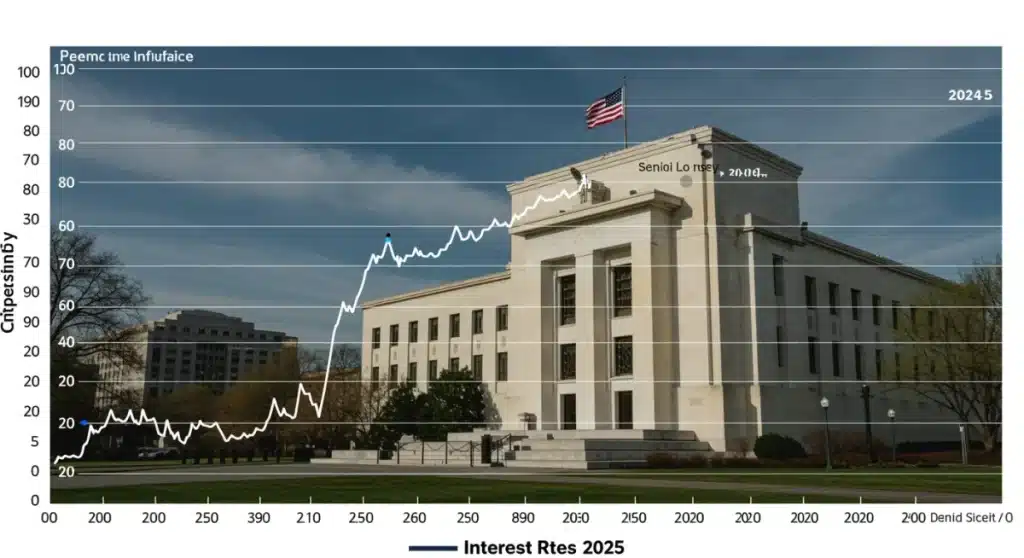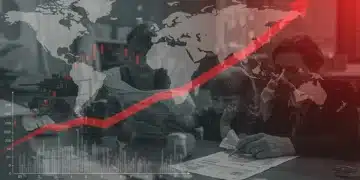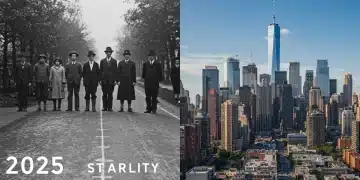Historical Fed Actions: Predicting 2025 Interest Rates

Understanding the intricate dance of economic forces and policy decisions is paramount for anyone keen on deciphering future market movements. The Fed Interest Rate Prediction for 2025 is not merely a guess but an informed projection rooted deeply in historical precedents of US Federal Reserve actions.
The Federal Reserve’s Historical Mandate and Tools
The Federal Reserve, often called the Fed, operates under a dual mandate: to foster maximum employment and maintain price stability. These goals are pursued through various monetary policy tools, which have evolved significantly over its century-long history. Examining how these tools were deployed in past economic cycles offers invaluable insights into potential future actions.
Historically, the Fed has primarily relied on adjusting the federal funds rate, conducting open market operations, and setting reserve requirements for banks. Each tool serves a specific purpose in influencing the money supply and credit conditions within the economy. The effectiveness of these tools often depends on the prevailing economic climate, as seen in periods of high inflation or deep recession.
Key Monetary Policy Instruments
The Fed’s arsenal of monetary policy instruments is robust, designed to address a wide array of economic challenges. Understanding these tools is crucial for anticipating how the Fed might respond to future economic shifts, particularly concerning interest rates.
- Federal Funds Rate: The target rate for overnight borrowing between banks, directly influencing short-term interest rates throughout the economy.
- Open Market Operations: The buying and selling of government securities to inject or withdraw money from the banking system, affecting liquidity.
- Discount Rate: The interest rate at which commercial banks can borrow directly from the Fed, serving as a backstop for liquidity.
- Reserve Requirements: The amount of funds banks must hold in reserve against deposits, influencing the amount of money available for lending.
Analyzing Past Cycles of Rate Hikes and Cuts
To predict 2025 interest rate impacts, it is essential to look at historical cycles of rate adjustments. The Fed’s decisions to raise or lower rates are rarely isolated events; they are part of broader campaigns designed to steer the economy toward its dual mandate. Each cycle offers unique lessons, yet common patterns often emerge.
For instance, periods of sustained economic growth and rising inflation have typically prompted the Fed to initiate rate-hike cycles to cool down the economy. Conversely, economic downturns or financial crises have led to aggressive rate cuts and quantitative easing to stimulate activity. The timing and magnitude of these interventions are critical variables that shape economic outcomes.
Notable Historical Rate Cycles
Reviewing specific historical periods can illuminate the Fed’s strategic responses to different economic pressures. These case studies provide a framework for understanding how current conditions might inform future policy decisions regarding the Fed Interest Rate Prediction.
- 1970s Inflation Battle: The Fed, under Paul Volcker, dramatically raised rates to combat runaway inflation, leading to a recession but ultimately restoring price stability.
- Early 2000s Dot-Com Bust: The Fed cut rates aggressively to mitigate the economic fallout from the tech bubble burst and the September 11th attacks.
- 2008 Financial Crisis: An unprecedented period of near-zero interest rates and quantitative easing was implemented to prevent a total economic collapse.
- 2022-2023 Inflation Fight: A rapid series of rate hikes aimed at curbing post-pandemic inflation, echoing some aspects of the Volcker era but in a different economic context.
Inflationary Pressures and Fed Responses
Inflation remains a primary concern for the Federal Reserve, and its historical responses to inflationary pressures are a cornerstone for predicting future actions. When inflation rises above the Fed’s target, typically 2%, the central bank is compelled to act. The nature and intensity of these actions depend on the perceived drivers of inflation and the broader economic context.
Past inflationary episodes, such as those in the 1970s and early 1980s, demonstrated the Fed’s willingness to implement significant rate hikes, even at the risk of inducing a recession. More recently, the post-pandemic surge in inflation saw the Fed embarking on its most aggressive tightening cycle in decades. This recent history is particularly relevant for the Fed Interest Rate Prediction for 2025.
Factors Influencing Inflationary Trends
Several underlying factors contribute to inflationary pressures, and the Fed continuously monitors these to inform its policy decisions. Understanding these factors provides a clearer picture of the challenges the Fed faces.
- Supply Chain Disruptions: Global events or logistical issues can restrict supply, driving up prices.
- Strong Consumer Demand: Robust spending, often fueled by fiscal stimulus, can outpace supply.
- Wage-Price Spiral: Rising wages leading to higher production costs, which then translate into higher prices, and vice versa.
- Energy Price Shocks: Volatility in oil and gas markets can have broad inflationary impacts across the economy.
The Role of Economic Data in Fed Decisions
The Federal Reserve is a data-dependent institution. Every policy decision, especially regarding interest rates, is informed by a vast array of economic indicators. These data points provide a real-time snapshot of the economy’s health, allowing the Fed to assess progress towards its dual mandate and adjust its course as necessary. Key indicators include inflation rates, employment figures, GDP growth, and consumer spending.
The Fed meticulously analyzes these reports, looking for trends and deviations that might signal a need for policy intervention. For instance, persistently high inflation combined with a robust labor market often paves the way for higher interest rates, while signs of economic contraction or rising unemployment might prompt a more dovish stance. This reliance on data makes the Fed Interest Rate Prediction a dynamic and evolving assessment.
Key Economic Indicators Monitored by the Fed
Monitoring these specific economic indicators is crucial for anyone attempting to anticipate the Fed’s next moves. Each data point offers a piece of the puzzle that forms the larger economic picture.
- Consumer Price Index (CPI): Measures the average change over time in the prices paid by urban consumers for a market basket of consumer goods and services.
- Personal Consumption Expenditures (PCE) Price Index: The Fed’s preferred measure of inflation, reflecting a broader range of goods and services than CPI.
- Unemployment Rate: Indicates the percentage of the labor force that is jobless and actively seeking employment.
- Non-Farm Payrolls: A measure of the number of people employed in the U.S., excluding agricultural, private household, and government workers.
- Gross Domestic Product (GDP): The total monetary or market value of all the finished goods and services produced within a country’s borders in a specific time period.
Global Economic Factors and Their Influence
The US economy does not exist in a vacuum; global economic conditions significantly influence the Federal Reserve’s policy decisions. International trade, geopolitical events, and the economic health of major trading partners can all impact domestic inflation, growth, and employment. The Fed must consider these external factors when formulating its monetary policy, as they can either amplify or mitigate domestic trends.
For example, a global economic slowdown could depress demand for US exports, affecting domestic production and employment. Conversely, strong global growth could contribute to inflationary pressures through increased commodity prices. Understanding these interconnected dynamics is vital for a comprehensive Fed Interest Rate Prediction.

International Economic Influences on the Fed
Several global factors have historically played a critical role in shaping the Fed’s policy outlook. These influences are constantly evolving, requiring continuous monitoring.
- Exchange Rates: A strong dollar can make US exports more expensive and imports cheaper, impacting inflation and trade balances.
- Global Commodity Prices: Fluctuations in oil, metals, and agricultural products can directly affect domestic inflation.
- Geopolitical Stability: Wars, trade disputes, or political unrest in key regions can disrupt supply chains and create economic uncertainty.
- Foreign Central Bank Policies: Actions by other major central banks can influence capital flows and relative interest rates, impacting the Fed’s decisions.
Predicting 2025 Interest Rate Impacts: Insider Knowledge
Leveraging historical precedents and current economic indicators, informed predictions for 2025 interest rate impacts suggest a nuanced approach from the Federal Reserve. While the fight against inflation has been aggressive, the Fed is keenly aware of the risks of overtightening and triggering a severe recession. The current consensus, based on insider knowledge from market analysts and former Fed officials, points towards a period of holding steady, followed by potential modest adjustments.
The pace of future rate changes will largely depend on how quickly inflation converges to the Fed’s 2% target and whether the labor market shows signs of significant softening. The Fed’s forward guidance, while often cautious, provides clues. Recent statements emphasize a continued commitment to data dependency, suggesting flexibility rather than a predetermined path for the Fed Interest Rate Prediction in 2025.
Scenarios for 2025 Interest Rate Trajectories
Based on current trends and historical patterns, several scenarios could unfold regarding interest rates in 2025. Each scenario hinges on different economic outcomes and the Fed’s subsequent policy reactions.
- Soft Landing Scenario: Inflation gradually declines to target while employment remains relatively strong, leading to a few modest rate cuts by late 2025.
- Recession Scenario: Persistent high rates trigger a significant economic downturn, forcing the Fed to implement more substantial rate cuts to stimulate recovery.
- Persistent Inflation Scenario: Inflation remains stubbornly high, compelling the Fed to maintain current rates or even consider further hikes, risking economic growth.
- Stagflation Scenario: A combination of high inflation and stagnant economic growth, presenting a complex challenge for the Fed with difficult policy choices.
| Key Point | Brief Description |
|---|---|
| Dual Mandate | The Fed aims for maximum employment and price stability using various policy tools. |
| Historical Cycles | Past rate hike and cut campaigns reveal patterns in response to economic conditions. |
| Data Dependency | Fed decisions are heavily influenced by economic indicators like CPI, PCE, and unemployment. |
| Global Factors | International trade, geopolitics, and foreign central bank policies impact domestic decisions. |
Frequently Asked Questions About Fed Interest Rates
The Federal Reserve operates under a dual mandate: to achieve maximum sustainable employment and to maintain price stability, typically targeting a 2% inflation rate over the long run.
Changes in the federal funds rate ripple through the economy, affecting borrowing costs for mortgages, car loans, and credit cards. Higher rates mean more expensive borrowing, while lower rates make it cheaper.
Quantitative easing (QE) is a monetary policy where the Fed buys large quantities of government bonds or other financial assets to lower long-term interest rates and increase the money supply, stimulating the economy.
The Personal Consumption Expenditures (PCE) price index is the Fed’s preferred measure of inflation because it captures a broader range of goods and services and accounts for shifts in consumer spending, providing a more comprehensive view.
While historical patterns offer valuable insights, they are not perfect predictors. Each economic cycle has unique characteristics. However, understanding past Fed responses helps forecast potential reactions to similar economic conditions in 2025.
What Happens Next
As the Federal Reserve navigates the complex economic landscape, all eyes remain on upcoming inflation reports and labor market data. The current trajectory suggests a cautious stance, with any significant shifts in the Fed Interest Rate Prediction for 2025 being highly dependent on these critical indicators. Investors and consumers should prepare for continued volatility and remain attentive to the Fed’s public statements and economic projections. The global economic environment, particularly developments in key trading partners and commodity markets, will also play a crucial role in shaping the Fed’s decisions in the months ahead as it strives to balance growth with price stability.





